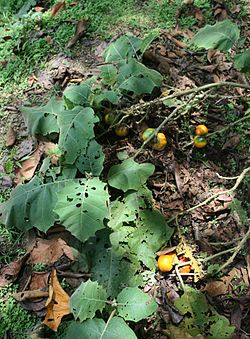Solanum sessiliflorum
| Solanum sessiliflorum subsp. var. | Cocona | |||||||||||||||||||||||||||||||||||||||||||||||||||||||
|---|---|---|---|---|---|---|---|---|---|---|---|---|---|---|---|---|---|---|---|---|---|---|---|---|---|---|---|---|---|---|---|---|---|---|---|---|---|---|---|---|---|---|---|---|---|---|---|---|---|---|---|---|---|---|---|---|

|
|
| ||||||||||||||||||||||||||||||||||||||||||||||||||||||
| ||||||||||||||||||||||||||||||||||||||||||||||||||||||||
Solanum sessiliflorum or Cocona is a tropical shrub belonging to the Solanaceae family. The cocona plant has sturdy branches and huge, serrate and hairy leaves. Its flowers are like large potato flowers, with light green petals. The fruit of cocona is a red, orange or yellow edible berry. Cocona hails from South America, where it is occasionally cultivated to be used for human consumption.
Cocona can also be grown as an indoor ornamental plant in colder areas, but it seems to be quite sensitive to spider mites, so care should be taken not to keep it in too dry air during winter. During summer, it can be grown outside or in a cold greenhouse. Cocona plant cannot tolerate frost.
Described on the Discovery Channel show Survivorman while in the Amazon Jungle in late 2007, they were said to provide a "flavor explosion," with a taste between a lemon and a tomato.
Solanum georgicum and Solanum hyporhodium were (and sometimes still are) included in this species, but they are generally treated as distinct today.[1]
Cultivation
Propagation
Pests and diseases
Varieties
Gallery
-
photo 1
-
photo 2
-
photo 3
References
- ↑ Cite error: Invalid
<ref>tag; no text was provided for refs namedss2005
External links
- w:Solanum sessiliflorum. Some of the material on this page may be from Wikipedia, under the Creative Commons license.
- Solanum sessiliflorum QR Code (Size 50, 100, 200, 500)


